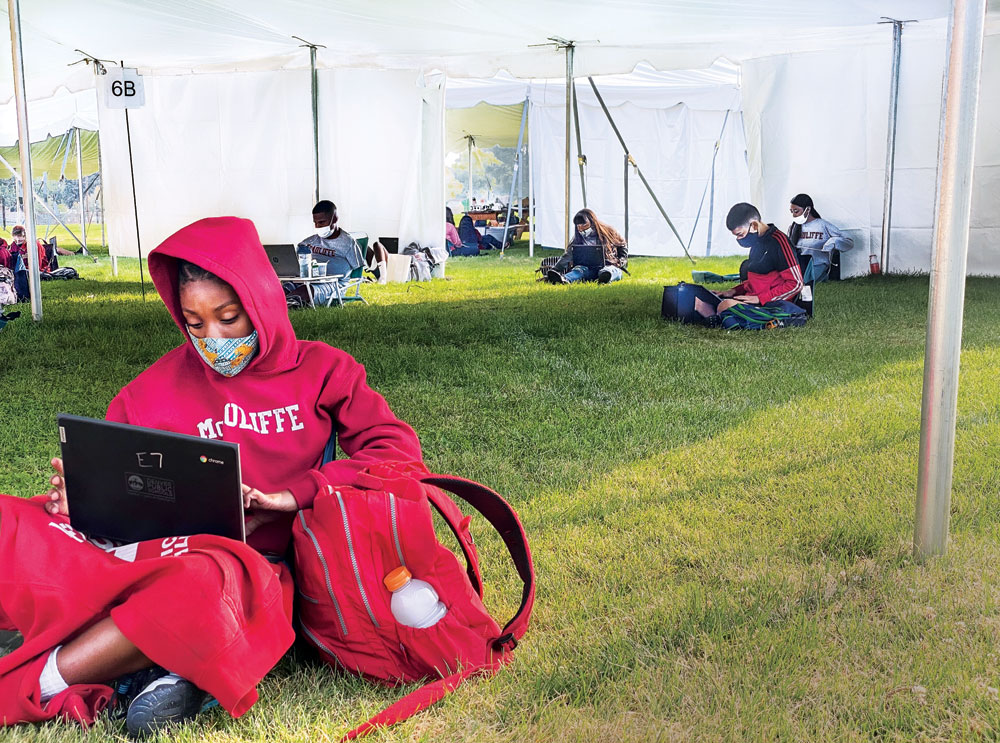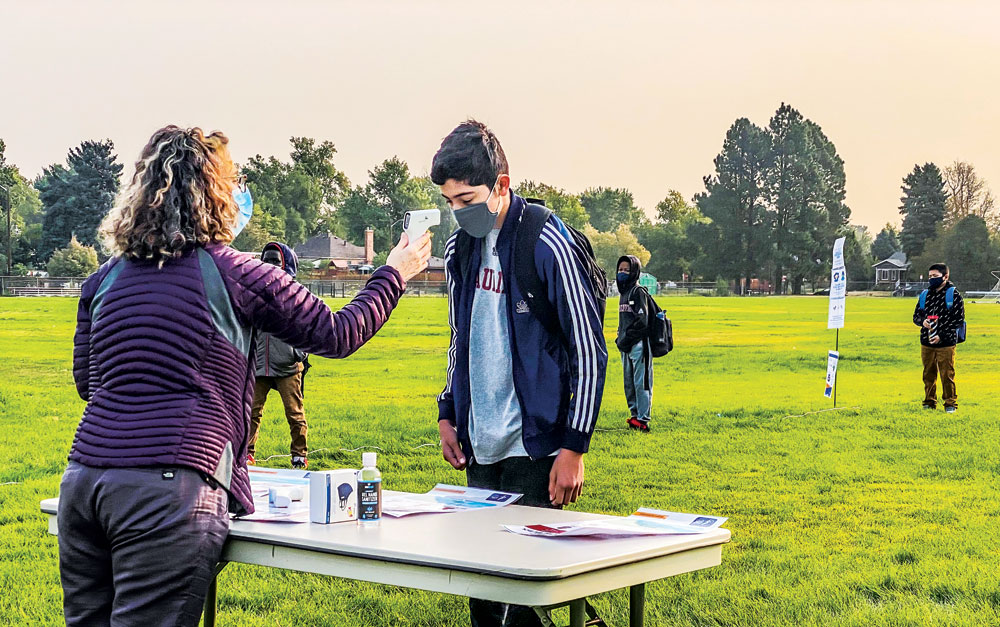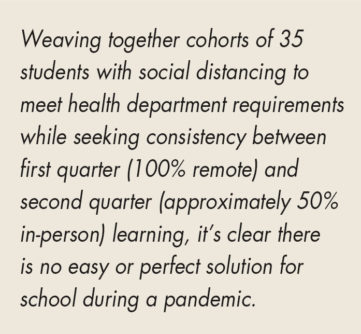
Some McAuliffe students, like Janiyah Wilson (foreground), opted to engage in remote learning within one of three grade-level tents the school purchased. Each tent is 4,000 sq. ft., and Principal Kurt Dennis says McAuliffe will continue using the tents once the building reopens to students in late October.
Listening to McAuliffe principal Kurt Dennis lay out the return-to-school challenges is reminiscent of an SAT math question. Each student cohort can include up to 35. Teachers can have up to two in-person cohorts. “Students could have up to four different teachers…That means, it’s basically one class that’s together in a room for the entire day and you would have up to four teachers who could come in and teach those kids a lesson.” But of course, in secondary school, students take six to eight classes, further complicating the math problem. “You’ve got juniors that are taking AP history and some are taking regular history and some are taking IB history and some are taking history for college credit…So how do you create a cohort where the kids who have all these niche courses, and world languages…?” It’s a scheduling nightmare.

Students will get a health check as they arrive on campus.
In fact, when you weave together these logistical challenges with social distancing requirements (3 feet minimum per DPS protocols) and seek consistency between first quarter and second quarter instruction, this math problem feels overwhelming. It is difficult to imagine an algorithm that can create cohorts and align students’ schedules to accommodate their individual academic requests and needs. Add to that coordination of siblings’ schedules across different schools to minimize transportation challenges in a school year without district-provided transportation for secondary students, and it’s clear there is no perfect solution.
Hybrid Learning Takes Many Forms
When McAuliffe shared its hybrid learning plan with parents on back-to-school night September 17, the limits of learning during Covid became clear to many who had fantasized about a return to the traditional school day. Students will return to school, but mandates from Denver Health and the district restrict how learning can take place. At McAuliffe, cohorts of 35 will engage in face-to-face learning with a teacher for only one class each day. The rest of the day, students will learn remotely, in the company of their cohort and an educator to keep them on track.
 Though many parents were dismayed at the plan, Stacy Russell, a Central Park mother of sixth-grade twins, is very upbeat after her son Clayton spent the week engaged in remote learning under one of the tents at McAuliffe. “It’s just been the best thing in the world,” she says. “All three of us were trying to work in the house, and it was super-hard.” She called McAuliffe to advocate for one of her sons, who was having a hard time staying focused on his remote learning from home. A few days into his week under the tent, “He says it’s just awesome. He loves it.”
Though many parents were dismayed at the plan, Stacy Russell, a Central Park mother of sixth-grade twins, is very upbeat after her son Clayton spent the week engaged in remote learning under one of the tents at McAuliffe. “It’s just been the best thing in the world,” she says. “All three of us were trying to work in the house, and it was super-hard.” She called McAuliffe to advocate for one of her sons, who was having a hard time staying focused on his remote learning from home. A few days into his week under the tent, “He says it’s just awesome. He loves it.”
Russell appreciates how McAuliffe educators and administrators are fully present for the students in a way that she couldn’t manage to do with her work schedule. “The reality is, I’m a single mom and I work full time, and I can’t help them. When things did go a bit awry, I wasn’t available. I hate that for my kids, but it’s also a reality. I just wanted him to have the best experience he could.” Her other son, Chase, is doing well with remote learning at home, but Russell understands that “they’re all different, how they work.”
Regis Jesuit High School (RJHS), a private Catholic school under Tri-County Health’s guidelines, returned for in-person learning August 17, with students working remotely two days a week and attending face-to-face classes two compressed days a week. RJHS Director of Communications Charisse Broderick King shared in an email that for the days students are on campus, “The class schedule ends each day at 12:40 pm, but we have removed our academic support period and lunch from the schedule and placed them in the afternoon to remove the times when students are more likely to congregate. The students attend their full complement of classes when they are on campus.”
Biology and forensics teacher Marianne Buehler says RJHS teachers and students rotate classrooms, and she is impressed with how both the administration and students have met the challenges of Covid. She has been able to innovate, too, to maximize the possibilities within Covid’s limitations. “I’ve created sub-groups within our groups. So if a cohort is in class and another cohort is at home, I have sub-groups from the in-class cohort and from the at-home cohort that are technically partnered so they can call each other on Teams and they can work together.”
Buehler sees a lot of promise with the hybrid model, which she thinks will become a part of school culture in the future, especially for student athletes and students touring colleges; rather than having to play major catch-up upon their return to campus, she thinks they’ll be more able to rely on online learning to keep up to speed with their peers on campus. She admits one concern about remote learning: “I worry about the death of the snow day, because there’s nothing like a good snow day,” she says with a smile in her voice.
In-Person Learning
DPS, which falls under Denver Health’s purview, shared secondary school guidelines with administrators in mid-September. These are nonnegotiable regardless of a school’s governing structure (traditional, charter, or innovation).
At McAuliffe, the move to in-person learning would have required significant schedule and teacher changes had the school attempted to offer more in-person classes. Children with 6 or 7 different remote classroom teachers cannot expect to meet in-person with those same 6 or 7 teachers. Dennis says McAuliffe wants to maintain as much consistency as possible across the two delivery methods. He communicated to parents that because of McAuliffe’s seamless approach to the two learning systems, students could opt for remote learning one day and in-person learning the next.
DPS high schools are finding it just as challenging to offer live instruction while staying within Denver Health and district guidelines. The return to school will likely feel anticlimactic to teachers and students alike. Northfield High School Principal Amy Bringedahl says “We have not given up on bringing students back but we are simply still working through multiple scenarios. Any return will be a phased-in return.” With 1,250 students and 1,250 complex schedules tailored to students’ different interests and needs, as well as a percentage of teachers who will be teaching 100% remote, the challenges are extensive.
Like McAuliffe, Northfield is focusing on maximizing consistency for teachers and students across first and second quarters. Northfield shared a communication to parents on September 22 noting that “Students who elect in-person learning will have the opportunity to come to Northfield to receive support with their academic learning, but teacher instruction will continue to be conducted virtually, as this provides us with the most consistency and reliability if students do get sick.” Northfield has extended its deadline to change one’s learning delivery option to October 14, and Bringedahl says almost 30% of Northfield students had elected to remain 100% remote.
Staggered school schedules (start and end times will vary by grade level at McAuliffe and Northfield is still weighing its options) temperature checks, closed campuses, and no bright orange school buses are among the many changes all families will need to adjust to as part of pandemic learning.
Front Porch photos by Christie Gosch




0 Comments